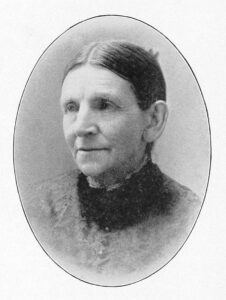
Nov 1, 2020
by Janet Thorngate
An Equal Rights Story for Today
This year Americans celebrated 100 years since the 19th Amendment to our Constitution assured women the right to vote. It was a long battle. Thirty-three years earlier, in one of the early skirmishes, ten women were arrested, indicted, tried, and convicted of voting illegally in Alfred, New York. Who were these women? And what in heaven’s name got into them? And what happened to them?
Alfred, of course, was a town settled by Seventh Day Baptists. By 1887, when this voting incident occurred, it had the largest SDB church in the country, and Alfred University (AU), started by SDBs, was a coeducation stronghold. Nearly half of the students and a large percentage of the faculty were women. So, were the ten voting women Seventh Day Baptists?
Who were these women?
A bunch of university students responding to a dare? Probably from the men students with whom they had debated “women’s rights”? The newspaper article announcing their arrest and indictment “for using the ballot box” listed their names and noted, “It is but just to remark that the ladies indicted embrace representatives of the very best of Alfred citizenship and they have got into this position from the belief that they were fully entitled to the privilege.”1 A good bit of sleuthing 133 years later reveals quite a bit about all but one of them (Eloise Livermore).
Their average age was 54, the oldest 64 (Ann Crandall Thomas 1823-1914), the youngest 23 (Alice Livermore Saterlee, born 1864—all the others old enough to be her mother or grandmother). All were married except the three 55-year-old widows, two of them widows since the Civil War twenty years earlier (Armida Livermore Heseltine, 1832-1905, and Abby Edwards Witter, 1832-1916, credited with initiating immediate organization of the SDB Women’s Society three years earlier in a speech to General Conference in Lost Creek, WV, 1884). Two were wives of AU faculty—and both on the faculty themselves! (Susan Crandall Larkin, 1832-1891, and Abigail Maxson Allen,1824-1902). One was wife of the AU Treasurer (Emily Sherman Green, 1827-1896). Several were members of the WCTU and the Women’s Society and Evangelical Society in their church (Emily Sherman Green, 1827-1896). One was a pastor’s daughter (Alice Livermore Saterlee, 1864-?), one a pastor’s wife (Abigail West Lewis, 1832-1909)—wife of a Seventh Day Baptist pastor. Indeed, all were Seventh Day Baptists.
What got into them?
The same newspaper article implied that they got the idea from Lucy Barber (Lucinda Lanphere Sweet Barber, 1833-1901), a farming wife who had voted in an Alfred area election the previous year. She had been arrested but the grand jury had failed to indict her. What got into them all were liberty of conscience and the valuing of freedom to speak out and take political action for causes they believed in.
What got into them were the ideas of Alfred University President Jonathan Allen and his wife Abigail. The couple led a forty-year period of radical reform that energized the college community and its town and sent generations of students beyond Alfred’s hills as supporters of a host of reforms, particularly antislavery and abolition, temperance, and women’s rights. President Allen gave his blessing as every male in the class of 1861 enlisted in the New York militia after President Lincoln’s call in April. Faculty continued to support them throughout their Civil War service; Allen conferred the degrees they would have earned had they finished their courses.
 “Equal rights” is a better term than “women’s rights” for the partnership Abigail and Jonathan Allen modeled and the roles they advocated. Two quotations of President Allen’s sum it up:
“Equal rights” is a better term than “women’s rights” for the partnership Abigail and Jonathan Allen modeled and the roles they advocated. Two quotations of President Allen’s sum it up:
“The essential powers of the spirit are neither masculine nor feminine, but human, sexless. Thought knows no sex.” For women to have equal education, equal opportunity, equal honors, and equal pay was “the most natural way in the world.”2
Abigail Allen, who as a young, district school teacher in the 1840s, had demanded and received pay equal to that of a man, was moved and motivated when Susan B. Anthony, first woman to speak at the state teacher’s convention in 1853, advocated equal pay for women teachers. They became friends and through the years she and President Allen
befriended feminists Caroline Dall, Julia Ward Howe, and Elizabeth Cady Stanton and invited them to the campus when other co-educational schools discouraged such visits.
And what happened to the ten women?
Lucy Barber had accompanied the ten voting women in 1887 but didn’t vote because she lived outside the municipality. When the ten were indicted, however, the prosecutor decided to re-open her 1886 case. This time she was tried, found guilty by the jury, and sentenced to one day in the county jail.3 Information on the final outcome for the other ten seems more elusive. A favorite among town folklore traditions about the event goes this way:
The women were taken to Belmont [county seat] to stand trial. The court was filled with excited spectators. Everyone in Alfred who could possibly arrange it took a day off to see what was going to happen to the leading ladies of the community. But as the proceedings began, the judge ruled that before they could proceed with the trial, they must first prove that they were women. This so horrified the good men of Alfred that charges were immediately dropped.4
A perhaps more dependable version comes from a tribute to Abigail Allen written just after her death in 1902 by Vandelia Varnum Thomas, an Alfred student who went on to Harvard, became a professor and widely known temperance lecturer.
No one can forget those autumn days of ‘87 when every paper large or small heralded in headlines the news that ‘Ten Women of Alfred voted and their votes were counted. The wife of President Allen was at the head.’…In few days all was over—arrested, tried, convicted, sentenced, though the sentence as yet has not been served…Yet notwithstanding the swift punishment of these good women, over one hundred women in the state offered their ballot that fall and about fifty were counted in.5
Vandelia Thomas describes Abigail Allen and the type of suffragette she was, hardly the usual stereotype of the “women’s libber.”
Naturally retiring and especially shrinking from notoriety, even in so just a cause, yet Mrs. Allen did not shirk and was always at the front ready to bear even more than her part in all that called for courage and endurance…To know was to be and to do, to help others to see, to hasten the better day… Abigail Ann Allen was the ideal
reformer, love giving motive, power, endurance, and faith.6
As we experience the emotion-charged political activism of our own time, again dealing with issues of racial justice, temperance and addiction, equal rights, and political privilege, we might do well to ponder the different world but similar issues of these spiritual ancestors. They were major leaders among Seventh Day Baptists in the last half of the 19th century. What responsibility do we have to express our convictions of right and wrong through political action, and with what attitudes and methods?
By Janet Thorngate, September 2020
Acknowledgments: Thanks to Oscar Burdick for remembering this story. Major source and initial inspiration for this article was Susan Rumsey Strong’s book listed in Note 2. Detail from newspaper articles, legal records, and the Alfred, NY, SDB Church records were compiled by Douglas Clarke (see Note 3). Biographical information on the women (plus much more than is here) is found in The Sabbath Recorder (index & archives at www.sdb history.org) including several long, glowing obituaries. Thanks also to Gay McRoberts of Janesville, WI, for research assistance in the SDB Historical Library and Archives there.
Notes:
1 Wellsville Daily Reporter, 25 Oct. 1887.
2 Susan Rumsey Strong, Thought Knows No Sex: Women’s Rights at Alfred University, Albany, NY: State University of NY Press, 2008, 1, 3.
3 Wellsville Daily Reporter, Oct. 25, 1887. This and other articles and records compiled by Douglas Clarke of Alfred: https://www.alleganyhistory.org/places/towns-and-villages/a-e274/alfred271/related-articles66/2967-the-women-of-alfred-voted-before-it-was-legal-for-them-to-do-so.
4 Helen Cottrell, “Alfred History—A Sketch.” Monograph No. 2, Alfred Historical Society, Feb. 11, 1968, 2.
5 Eva St. Clair Champlin and Frances Babcock, Eds. An
Offering to the Memory of Abigail Ann Allen by the Ladies’
Literary Societies of Alfred University, [1902], 56-57.
6 Ibid. 58.

